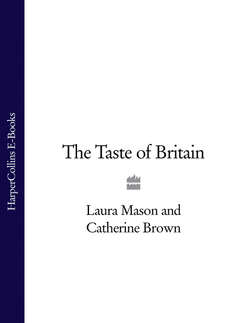Читать книгу The Taste of Britain - Hugh Fearnley-Whittingstall - Страница 211
HISTORY:
ОглавлениеThe British have concentrated on the development of a uniquely wide spectrum of flavours and qualities in apple varieties; some of the finest are known as pippins. The word originally denoted an apple raised from seed as opposed to multiplied by scions. Morgan & Richards (1993) remark, ‘in time the term “pippin” came to be synonymous with fine-flavoured late-keeping English varieties’. From Tudor times, pippins of various types have been popular and commercially important. At first the Golden Pippin was esteemed for making jellies and tarts. Then, the Ribston Pippin (Yorkshire), the Wyken Pippin (Warwickshire) and the Sturmer Pippin (Suffolk) arose, which remained important through the nineteenth century.
The Cox’s Orange Pippin was raised by Richard Cox in Buckinghamshire. It is believed to have been grown from a pip of a Ribston Pippin. Commercialization took place in the 1860s in the neighbouring county of Hertford and it was widely planted in southern England over the next 30 years. Roach (1985) illustrates an orchard of Cox’s Orange Pippin on dwarfing rootstocks in 1865. Today, it is the most important British dessert apple. Several clones are grown, including the Queen Cox. As well as being valued for its fruit, the Cox, crossed with other varieties, was the source of various late-season dessert apples, including Ellison’s Orange, Epicure, Fortune and Laxton’s Superb, several of which are still grown on a small scale.
Other notable varieties classed as late-season dessert types have complex aromatic flavours - sometimes reflected in their names, such as Cornish Gilliflower and Pitmaston Pine Apple (whose honeyed flavour is considered reminiscent of that fruit). These, and many others, were greatly enjoyed by Victorian and Edwardian connoisseurs when fine-flavoured dessert apples were much appreciated by the rich. That wealth of varieties has since reduced as a consequence of the modern emphasis on ease of growth and handling, and the uniform and attractive appearance demanded by supermarkets. However, a renewal of interest in rarities has been prompted by enthusiasts.
Many of these apples are now much grown abroad, including the Cox and the Sturmer. Controlled-atmosphere storage, very important to Cox’s and some other late-season apples, has been used in Britain since the 1920s. Cox’s Orange Pippin is generally eaten raw, although it can successfully be used in pies, tarts and cooked desserts. Some aromatic dessert apples have been used for single-variety juices.
